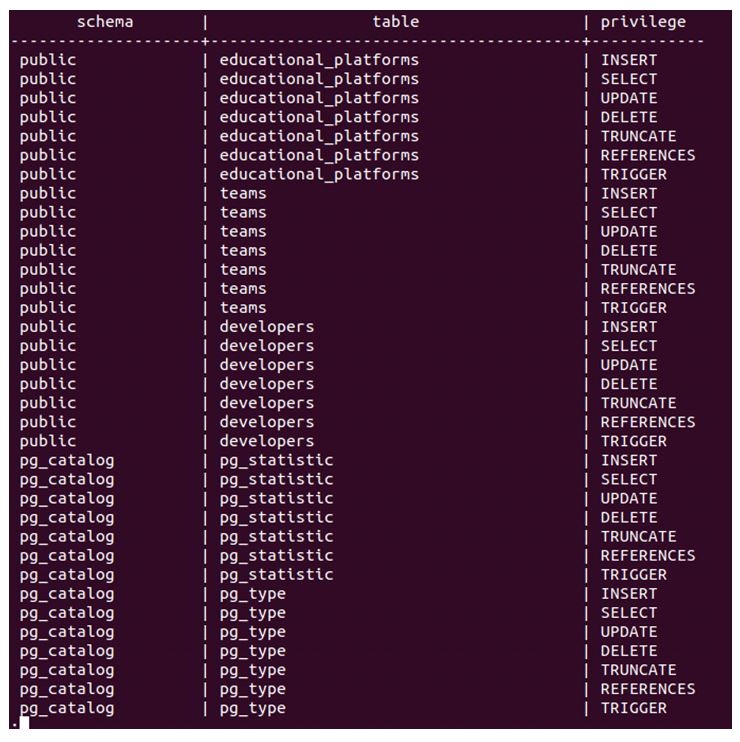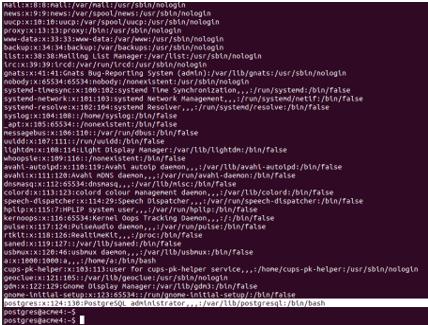
In this case, the current database is also called postgres, which is the same as the username.

LIST USER POSTGRES PASSWORD
Enter the CURRENT SUPERUSER password for sudo. $ sudo -u postgres psql - Run command "psql" as UNIX USER "postgres". To run psql using "UNIX USER" postgres, you need to invoke " sudo -u postgres psql", which switches to "UNIX USER" postgres and run the psql command. Login as PostgreSQL Superuser " postgres" via " psql" Client The UNIX USER postgres cannot login interactively to the system, as its password is not enabled. The PostgreSQL installation creates a "UNIX USER" called postgres, who is ALSO the "Default PostgreSQL's SUPERUSER". Login to the PostgreSQL Server Default PostgreSQL Superuser " postgres" I will describe these tools in later sections. share/postgresql-common/pg_wrapper* Graphical Clientsīesides the command-line client psql, many graphical clients are available to access PostgreSQL, e.g., pgAdmin3, PhpPgAdmin (for PHP, model after PhpMyAdmin), etc. Lrwxrwxrwx 1 root root 37 xxx xx xxxx /usr/bin/createuser ->. Lrwxrwxrwx 1 root root 37 xxx xx xxxx /usr/bin/createdb ->. The directory /usr/lib/postgresql/10/bin also contains many utilities such as createdb (create database), dropdb (drop database), createuser (create PostgreSQL user), dropuser (drop PostgreSQL user), among others, with symlinks defined in /usr/bin. The actual program and utilities are located at /usr/lib/postgresql/10/bin and linked via pg_wrapper. Psql is a symlink located in /usr/bin (a PATH entry). The PostgreSQL installation provides a command-line client program called psql, which can be used to login to the server. c config_file=/etc/postgresql/10/main/nf usr/lib/postgresql/10/bin/postgres -D /var/lib/postgresql/10/main You could display the PostgreSQL server process via: There is also a symlink called postmaster in the same directory. The PostgreSQL server program is called postgres (in directory /usr/lib/postgresql/10/bin). The PostgreSQL server accepts connection by client program over the TCP/IP network. $ sudo systemctl status postgresql // Show th status $ sudo service postgresql reload // Reload the configuration without stopping the service // OR $ sudo service postgresql restart // Stop and restart the service

$ sudo service postgresql start // Start the service $ sudo service postgresql stop // Stop the service The postgresql service is started automatically upon startup. In Ubuntu, the server is run as a service called postgresql (configured in /etc/init.d/postgresql). PostgreSQL runs as a client-server system. Reference: PostgreSQL Documentation - Tutorial.

$ which psql // psql is an interactive PostgreSQL client Postgresql: /etc/postgresql /usr/lib/postgresql /usr/share/postgresql.
LIST USER POSTGRES INSTALL
$ sudo apt-get install postgresql postgresql-contrib // Verify the installation
LIST USER POSTGRES UPDATE
$ sudo apt-get update // Install PostgreSQL Installing PostgreSQL 10.6 Ubuntu // Refresh the apt-get repository The mother site for PostgreSQL is with manual. The project started in UC Berkeley in 1986, and is now developed by a group of volunteers called "PostgreSQL Global Development Group". It supports a large part of the SQL standards such as foreign keys, triggers, views and transactions and object-oriented features such as inheritance. PostgreSQL is an open-source Object-Relational Database Management System (ORDBMS).

I assume that you are familiar with SQL commands (such as CREATE TABLE, DROP TABLE, INSERT, SELECT, UPDATE and DELETE).


 0 kommentar(er)
0 kommentar(er)
